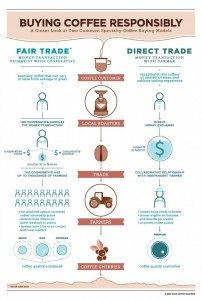LA JOLLA, CA – Specialty coffee retailer, Bird Rock Coffee Roasters, released the first infographic explaining key differences between fair trade and direct trade coffee to help educate consumers, roasters and farmers about the differences and benefits of a direct trade model over the widely used fair trade practice.
Through the direct trade process, Bird Rock Coffee Roasters is able to work directly with the farmers who grow coffee, and by removing the third party exporter.
The direct trade model results in more money for the farmers, and better quality coffee for the consumers. This has helped Bird Rock Coffee Roasters receive recognition for their roasting and sourcing efforts, including the coveted “Roaster of the Year” award in 2012.
“Bird Rock Coffee Roasters has seen the benefits of direct trade coffee sourcing firsthand,” said Chuck Patton, owner of Bird Rock Coffee Roasters (click to enlarge).
“Helping individual farmers improve their sustainable farming practices wouldn’t be possible through the alternative, fair trade model, which doesn’t allow for individual transactions, and often results in lesser-quality coffee. While the direct trade model may not be the easiest way to source coffee, here at Bird Rock Coffee Roasters, we believe it’s the most ethical.” The infographic developed by Bird Rock Coffee Roasters aims to show the differences between direct and fair trade, and highlights the main points of differentiation, including money handling, percentages of income that the farmers receive and feedback from the roasters, all ultimately leading up to the quality of the coffee.
Also, since the term “direct trade” is not officially defined by the coffee industry, this infographic is an attempt to define the term and how it applies to many of the coffees that Bird Rock Coffee Roasters secures.
Source: Bird Rock Coffee Roasters


















